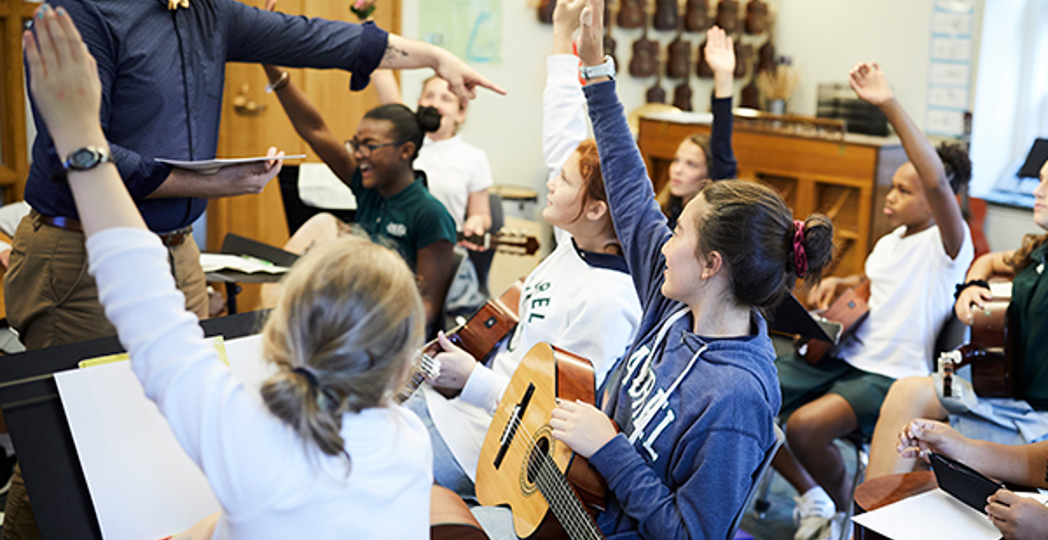Teaching Music From A Distance: How It Feels
by Arbela Capas | May. 15, 2020 | 3:00 PM

Editor’s Note: As Cleveland deals with the outbreak of the new coronavirus, or COVID-19, everyday life is being disrupted. In our new series “How It Feels,” we’re talking to students, teachers, nurses and those on the frontline of the pandemic to see what it feels like to live life in isolation and transition to new ways of working, thinking and living. Click here to read more Clevelanders' accounts.
On any normal school week, Joel McDaniel’s schedule is packed. First, he has his job as a choir teacher at Laurel school from 8 a.m. to 5 p.m. Then comes private lessons at the Music Academy and at Baldwin Wallace.
But since April 2, the date spring break ended and the stay-at-home order kicked in for the school, his choir room has turned into a synchronous digital class through Google Meet. While many educators have had to improvise, adapt and find ways to engage their students virtually, the art of music has proven to be difficult to teach through a digital format, McDaniel says.
“The energy for teaching online is very one-sided, and it's tiring,” McDaniel says. “You can't have back and forth discussions as fluidly or organically, so it makes digging into certain content or topics harder because you're not getting the immediate feedback and curious energy that happens when you're in a physical class together.”
McDaniel, who has been teaching music in the Cleveland area for six years, has been learning new ways to adapt to this new teaching style, as well as how to translate voice lessons, piano instruction and whole choir rehearsals through a virtual platform. He shares some of the ways him and his students have been adapting, along with some unexpected positives that have come from a new digital classroom model.
When things started to change, at the lower level we started to come up with different ideas on how to transfer learning to home pretty quickly. Our division was really on top of it as we have an online learning platform that was really helpful. Our department started creating videos for the students, especially for primary students, to keep them engaged. We did sing alongs. The dance teacher read books and did action dances. So a lot of cross-divisional work, just prepping because we had the inkling that something was coming.
The girls at Laurel have been so absolutely amazing. They step up to every challenge that we've been giving them, which is really cool. I haven't had any issues with attendance, the girls are showing up to class on time. They're wanting to get together because our group is so close knit, and they just want to have that socialization and sense of community that they really aren't getting anymore. And classes that are synchronous classes are a sort of balance of content and also the socialization that they really crave and need. When you can't really sing together, I think that's the second-best thing.
Private lessons are a little tricky because, especially for the younger students, it's a lot more on their shoulders, I think. It requires a lot more self-awareness as far as the music side of things, which is hard to develop in the first place. Some of the girls are really, really stepping up to that and others are struggling, but they're making strides that they wouldn't have made if you're standing over their shoulder saying, “No, that's wrong.” They’re trying to develop their own musicianship a little bit more.
It's nice because it makes you fall back more to the fundamentals and really strip things down to the step-by-step instructions. So like: “Let's walk through this in a sequence” or “Let's walk through this in an individual process.” And as we've gone through lessons, I see it more and more, especially with my younger kids; they're walking through that process. The in-depth discussions I’ve had with my college students show that they're able to more closely assess their musicianship and not be fully relying on me as the instructor. They’re now starting to flip it onto themselves.
Obviously, you try things and some things just fall flat. Because, nobody's trained for teaching like this. Obviously, everything that we're doing now is not necessarily going to work in a physical classroom. But I think the balance of infusing some of the old methodology with this new way of teaching, and the new collaborative aspects of it, will really strengthen what we're doing as teachers in the classroom.
Trending
-
1
-
2
-
3
-
4
-
5










